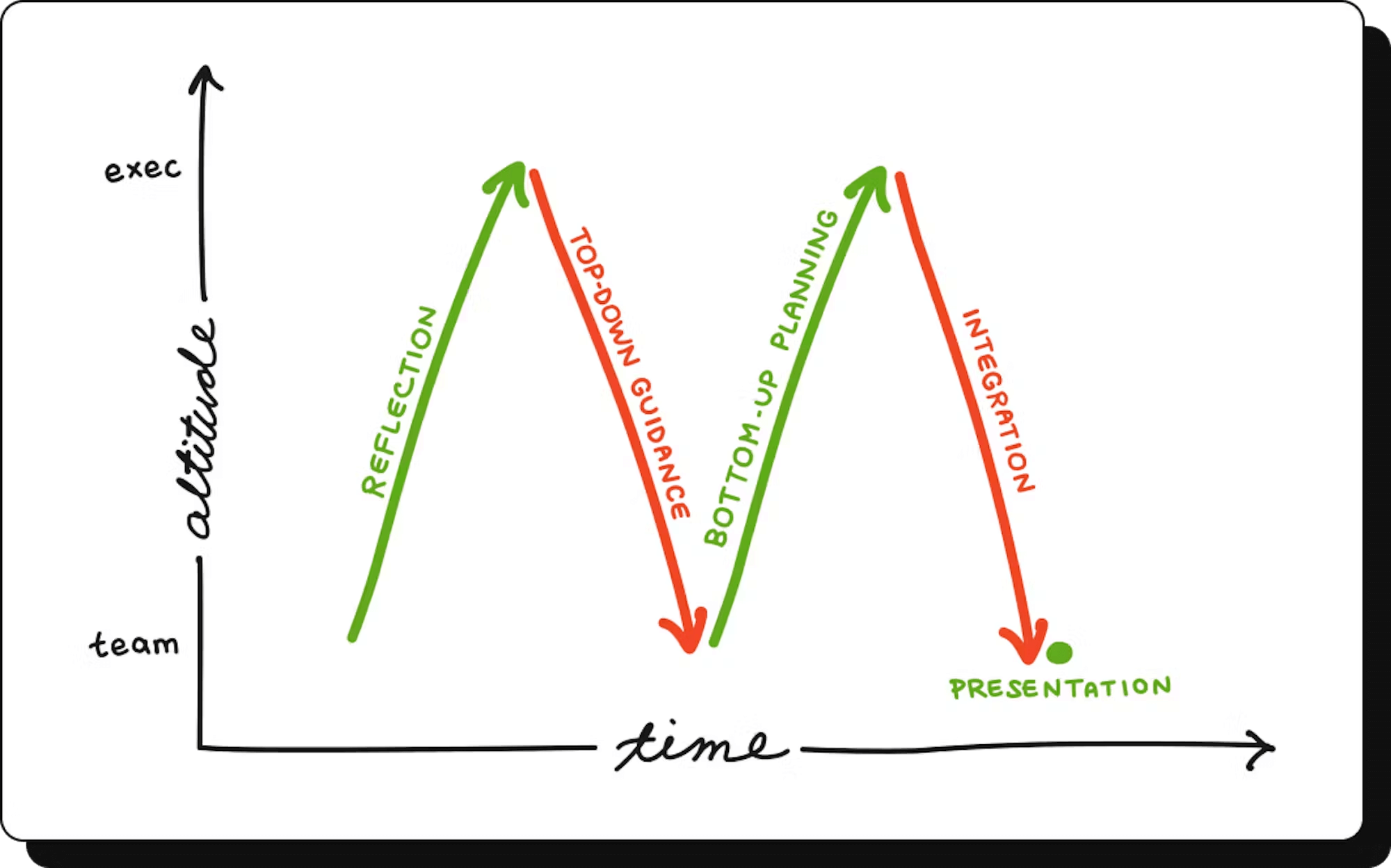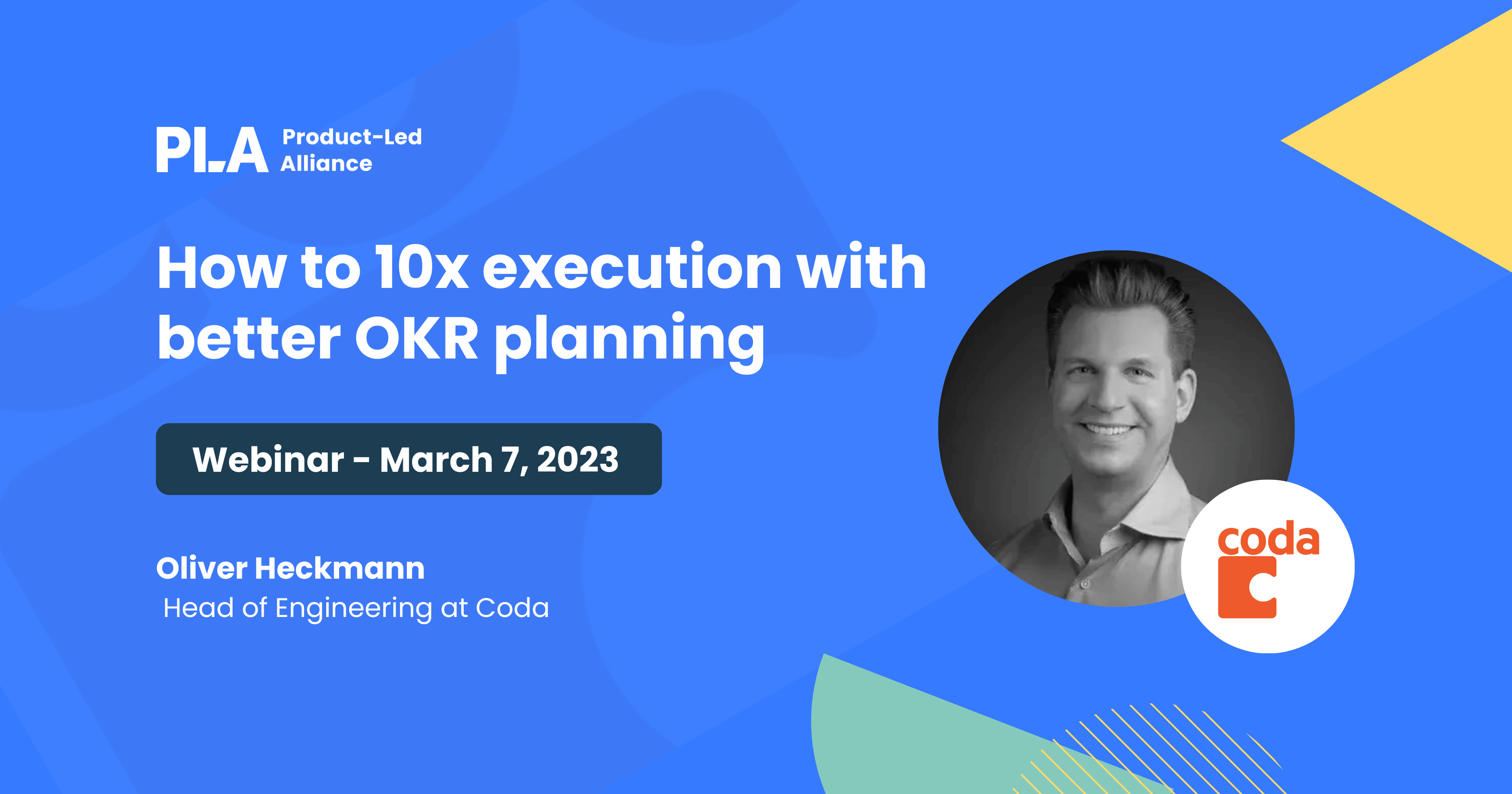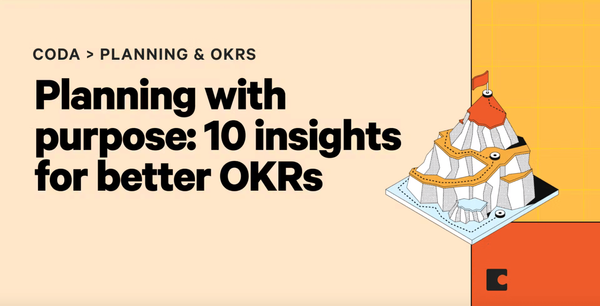Hi, I’m Oliver, Head of Engineering at Coda. Before joining Coda in 2021, I spent 14 years as VP of Engineering at Google, where I ran the YouTube Creator, Google Travel, Google Shopping, and other teams. Along the way, I built a litany of products like Google Flights, Google Shopping Ads, YouTube Content ID, Gmail Frontend, and many more.
Throughout my career, I’ve developed a passion for planning, goal setting, and OKRs (Objectives and Key Results). It started when I read Andrew Grove’s High Output Management—a book that laid the foundation for the OKR framework—when I went to university in Germany.
I was inspired to see the huge impact that simple planning and a focus on priorities could have. Over the last 25 years, I’ve had the opportunity to lead and advise companies on their planning processes. And I've seen many common challenges and patterns of success. I have simplified them into 10 key insights below.
Insight #1: Embrace both top-down and bottom-up planning
Bottom-up planning is when you involve all the employees in planning. This combines all the brain power of the best people at your company. Conversely, top-down planning is when decision-making happens at the top and is then communicated down through your hierarchy.
This can give clear direction and ensure that nobody’s over-committed. Top-down and bottom-up motions each have their strengths. This is why the best teams use both - embracing an M-shaped planning process, as pictured, to ensure all ideas have been heard and accounted for.
More specifically, the best teams begin with top-down guidance before initiating bottom-up planning so that the company’s strategic objectives and high-level priorities steer each team’s focus.

Insight #2: Reflect on the past before making future plans
You rarely start from zero when planning - you always have a previous planning period - so it’s important to reflect on what went well and what didn’t. These reflections can help inform your top-down guidance as you begin a new planning cycle.
Dedicating time to reflect will improve your plans when done correctly. If you’re not learning from the past, then the assumption is that you’re either perfect or unable to adapt. Both of these beliefs are dangerous!
Insight #3: Don’t blindly copy someone else’s planning tool or process
The OKR framework is a key planning framework, and I believe it was a big reason why Google hit so many of its ambitious targets. But what worked for Google will not work perfectly for you. I guarantee headaches if your company directly copies another’s OKR framework and then expects success to follow.
Before creating any planning template, think about what to emphasize with your planning framework. What are you trying to achieve with your planning process? That answer should give one or two key focuses. Here are some examples of a focus you might land on:
- Promote idea generation.
- Strengthen the bottom-up planning phase.
- Ensure top-down guidance and dependencies between teams are handled well.
- Model how headcount aligns to plans with a resourcing matrix.
- Develop better metrics to keep teams accountable.
When you are clear about your goals, you can pick an OKR template and adjust it to your needs. Try these 8 free OKR templates from Coda’s Solutions Architects for inspiration.
Insight #4: Centralize your planning information
Your team constantly sorts through information, such as emails, presentations giving guidance, documents with customer insights—and oh, and feature requests just came in!
What is then presented as “the plan” is a table of objectives and key results that are often missing the context of the information listed above. Not to mention that the email with the OKR presentation will be hard to find in three months.
People need the what, but also the why and how of planning—the context. The actual plan is the aggregate of all of that information. Keep it all in a single place.
Insight #5: Integrate planning and execution
The most important part of planning starts right when your planning period ends: the execution of those plans. The best plans are worthless if not followed up by good execution.
However, in most companies, planning and execution are too decoupled. For example, task tracking and other execution-related efforts are done in tools that are completely separate from OKR planning. This leads to many issues: plans and execution drifting apart, tracking progress against plans becomes hard and thus does not happen continuously, etc.
In my experience, the best solution is to have planning and execution live in the same tool, and therefore execution becomes a simple extension of the plans. This can be as simple as integrating your OKRs into your team hub, and can go as far as directly tying all tasks to their related KR, leading to automatic OKR updates as tasks progress.
Because of the importance of this, it was important to me to optimize our own product, Coda, to be both excellent at managing and tracking tasks, bugs, as well as integrating tightly with GitHub, Jira, and other execution-related environments, while at the same time being an excellent planning tool for OKRs—allowing for plans and execution to be tightly integrated.
Learn more about Coda for planning and OKRs.
Insight #6: Don’t confuse goals with stretch goals
If your team isn’t clear on what level of completion they must hit versus what they would like to hit, you create a culture where people are concerned more about their own performance than the company’s performance.
When I was at Google, we encouraged our teams to set very ambitious goals for their OKRs — and because they would often not be achievable, achieving 70% was considered a sufficient success. However, this made it hard for dependent teams to plan reliably, as they couldn’t be sure how much would get done.
When I advise companies on their OKR processes, I suggest marking each goal as one of two types:
- The primary goal: Deliver X by Y. This is a real deadline. We will push hard to get this done 100% by Y. Everything lower than 100% is a fail. Other teams can expect this work will get done.
- The stretch goal: Ambitious, high-shooting goals. We will probably not get to 100%—maybe we don’t know enough to determine what is realistic—but we will push hard. Stretch goals are optional, and I would recommend to only use them sparingly. When using them, mark them clearly as a stretch goal.
When you use this two-pronged approach, and clearly mark which type each goal is, you set clear expectations while allowing your team to dream big and surpass expectations.
Insight #7: When success is obvious, don’t waste time measuring it
Measuring success is critical to OKR planning. But it often gets overdone. Don’t waste time implementing complicated one-off success metrics when success or failure are plain to see.
Don’t try to define a success metric for a launch when that launch is an obvious improvement to your users. In those cases, make it a simple getting-the-feature-out metric. Use the time you gain toward obsessing about the metrics that really matter—when success is not obvious.
This is especially important for startups, where you are still building ways to measure success and you typically have a gigantic list of relatively obvious product improvements.
When I’m assessing whether or not to analyze a metric, I’ll ask a series of questions like:
- Do you have the capability to measure this?
- Is instrumenting the metric as much work as building the feature itself?
- Is it obvious this goal will move things in the right direction?
- Is it more efficient to just double down on execution and move on to the next thing?
By the time I’m done, I’m usually clear-eyed about the need for pursuing success metrics - specifically the ones that matter.
Insight #8: Write your plans in pencil, because things will definitely change
It’s an inescapable reality that sometimes things will change before your next planning cycle, and some of your current plans will no longer make sense. I’ve seen three patterns to allow for mid-cycle changes:
- Sticking to the plan: Planning cycles tend to be three months, which is far too long to be going down the wrong path.
- Ignoring the plan: Trying to do the right things while not following the plan, which trains everyone to ignore the plan from the outset.
- Adapting the plan to the changes: Making decisions and sticking to them, but allowing for exceptions. Adjust plans if the world changes, instead of going down the wrong path until the next planning period starts.
In the end, your OKRs are just data in a table. If you have to change your execution, you should ensure that change is reflected in the plan.
Insight #9: Don’t spend more than 10% of your time planning
When I joined Coda, we had a ritual of two-week planning sprints, followed by a quarter of execution. These were quite intense two-week periods—and they felt long.
After I was at Coda long enough to have the courage to experiment, I changed the planning period to a single week. I theorized that if we had an additional week for execution, we’d get more done. In the end, we want to maximize the company’s output.
Perhaps counterintuitively, we found that the single week of planning led to more meticulous OKR definitions, more thoughtful goals, higher levels of happiness, and better business outcomes. A single, concentrated week forced total focus on planning and left more time for execution. This is not to devalue the work of planning, but to stress the bigger importance of execution.
Why 10%? Well, I like round numbers. 20% is quite easy to achieve and does not push you enough to really streamline every aspect of planning - hence I set the goal to 10%.
Insight #10: Don’t confuse OKRs with strategy or vision
Often, people have an OKR process that they run through, and then they’re done. The issue is that this process lacks the strategizing that describes how the company wants to move toward its long-term vision.
While completing your OKR process without checking in on your strategy or vision is possible, I strongly advise against it. OKRs are simply a reflection of movement - based on your strategy - that ultimately get you closer to your vision. You need all three to be successful.
Be sure to incorporate your strategy and vision alongside your OKRs in your next planning cycles: Repeat your company vision at the top of the planning document, write down (or repeat) your strategy as part of your top-down guidance to the team and have it live in your planning document, then create your OKRs in the same document.
If you miss either vision or strategy, prioritize creating those overwriting OKRs.
Build an efficient and effective planning process with Coda
Perhaps the most important insight I’ve learned is that having a powerful but flexible tool to run your planning process is tremendously important. I learned while at Google that limitations and inflexibility in spreadsheets directly impact the quality of plans and the resulting execution.
At Coda, we naturally use Coda for our OKRs. It allows our teams to share context on our vision and strategy, plan bottom-up and top-down, reflect together on the past, and plan for the future - all in one centralized place.
From what I’ve learned running Coda’s OKR process, and advising hundreds of other companies running planning on Coda, I created The Ultimate Coda Handbook for Planning & OKRs.
Curious to learn more about how Coda thinks about planning?
Join me for: How to 10x execution with better OKR planning.👇




 Follow us on LinkedIn
Follow us on LinkedIn



